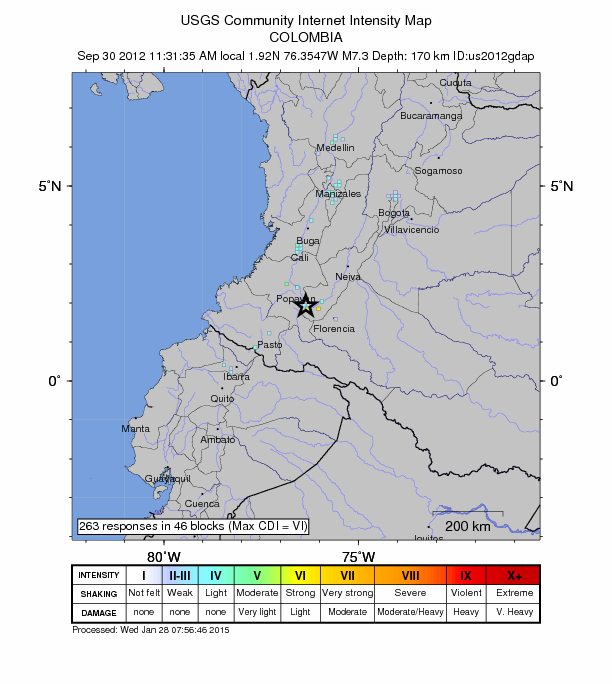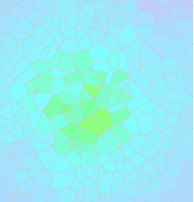M 7.3 - 11 km WNW of San Agustín, Colombia
- 2012-09-30 16:31:35 (UTC)
- 1.929°N 76.362°W
- 170.0 km depth
Interactive Map Regional Information Felt Report - Tell Us! 000599Responses Contribute to citizen science. Please tell us about your experience.
- Did You Feel It?
VIImmi 
Community Internet Intensity Map - ShakeMap
VImmi 
Estimated Intensity Map Origin - Review Status
- REVIEWED
- Magnitude
- 7.3 mww
- Depth
- 170.0 km
- Time
- 2012-09-30 16:31:35 UTC
Moment Tensor Fault Plane Solution View Nearby Seismicity - Time Range

± Three Weeks - Search Radius

250.0 km - Magnitude Range

≥ 4.0
Contributors US
USGS National Earthquake Information Center, PDE
Tectonic Summary
The September 30, 2012, M 7.3 earthquake west of Isnos, Colombia, occurred as a result of normal faulting at an intermediate depth, approximately 170 km beneath southwestern Colombia within the subducting Nazca slab. Focal mechanism solutions indicate that rupture occurred on either an east- or southwest-striking normal fault. The earthquake ruptured a fault in the interior of the inclined subduction zone that dips to the east-southeast beneath South America, having begun its descent into the mantle at the Colombian-Ecuador Trench offshore of Colombia and Ecuador. The event resulted from stresses generated by the slow distortion of the subducting plate as it descends through the mantle, rather than on the thrust interface that constitutes the boundary between the Nazca and overlying South America plates; the latter is active only near the Earth’s surface, while the subducting Nazca plate generates intraplate earthquakes to depths of 200 km or more in this region. Slip on a fault aligned with either nodal plane of the focal mechanism solution is consistent with this intraplate setting. At the location of this event, the Nazca plate moves east-northeast with respect to the South America plate at a rate of approximately 60 mm/yr.
Earthquakes like this event, with focal depths between 70 and 300 km, are commonly termed “intermediate-depth” earthquakes. Intermediate-depth earthquakes represent deformation within subducted slabs rather than at the shallow plate interface between subducting and overriding tectonic plates. They typically cause less damage on the ground surface above their foci than is the case with similar-magnitude shallow-focus earthquakes, but large intermediate-depth earthquakes may be felt at great distance from their epicenters. “Deep-focus” earthquakes, those with focal depths greater than 300 km, also occur in the subducted Nazca plate farther east from the Peru-Chile Trench, beneath central Colombia, western Brazil, and central Argentina. Earthquakes have been reliably located to depths of about 650 km in this region.
Earthquakes of this depth in this region of the Nazca plate are fairly common; 13 similar events deeper than 100 km have occurred over the past 40 years, within 500 km of the September 30th earthquake. The largest was a M 7.1 earthquake at a depth of 206 km in August 2010, 380 km to the south of the September 30th event, that caused only slight damage to the surrounding area.
Hayes et al. (2016) Tectonic summaries of magnitude 7 and greater earthquakes from 2000 to 2015, USGS Open-File Report 2016-1192. (5.2 MB PDF)


